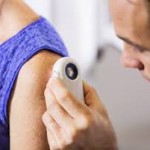SKIN CHECKS
Approximately, two in three Australians will be diagnosed with skin cancer by the time they are 70, with more than 750,000 people treated for one or more non-melanoma skin cancers in Australia each year. Non-melanoma skin cancer is more common in men, with almost double the incidence compared to women.A skin check appointment involves:
- History taking and an assessment of your personal risk for skin cancer
- A full clinical skin check
- Education about prevention of skin cancer and how to perform self-checks to detect any developing skin cancer
- Appropriate individual skin management
At Durrant Medical Clinic our doctors are experienced to undertake full body skin checks and perform skin cancer removal, if required.

Our GPs use a handheld dermatoscope as used by specialist dermatologists and is the screening tool recommended by the Australian Cancer Network to pick up malignant melanoma and other skin cancers.
Our practice is equipped to carry out procedures that treat pre-cancerous sun spots, various skin lesion biopsies and surgical excisions of skin cancers (biopsy). A biopsy is a quick and simple procedure and is performed in our treatment room. You will be given a local anaesthetic to numb the area, and a small piece of tissue is cut from the spot or the skin spot is cut out completely in a procedure called an excision.
Often stitches are used to close the wound and help it heal. The tissue that is cut out will be sent to a laboratory, where a pathologist will examine it under a microscope. The results will be available in about a week. You will be required to book a follow up appointment for the results.
In some instances, your doctor may need to refer you on for more specialised care depending on your biopsy results or skin lesion location.
Prevention:
For best protection, we recommend a combination of sun protection measures:
- Slip on some sun-protective clothing – that covers as much skin as possible
- Slop on broad spectrum, water resistant SPF30+ sunscreen. Put it on 20 minutes before you go outdoors and every two hours afterwards. Sunscreen should never be used to extend the time you spend in the sun
- Slap on a hat – that protects your face, head, neck and ears
- Seek shade
- Slide on some sunglasses – make sure they meet Australian standards.





